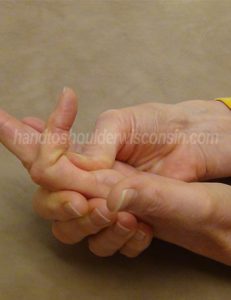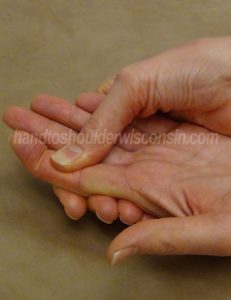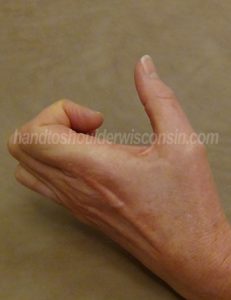Hand to Shoulder Center of Wisconsin has a team of orthopedic specialists who are here to diagnose and treat your symptoms of a ganglion mucous cyst. Learn more about this hand condition and contact us at either location in Appleton or Green Bay for more information.
Mucous cysts are a type of ganglion. They are fluid-filled sacs that are typically found at the finger joint closest to the fingernail, better known as the DIP joint. The stalk of the mucous cyst is often connected to the DIP joint. Mucous cysts are firm and do not easily move under the skin. They may become painful, however, most mucous cyst are not. At times, the location and pressure from the cyst on the nailbed may cause a groove in the fingernail. Mucous cyst ganglions often will develop in middle age or older patients with wear and tear arthritis, also known as osteoarthritis. This type of ganglion cyst is commonly more prominent in women than men.
The exact reason why a mucous cyst develops is unknown; however, one theory suggests that underlying bone spurs from the arthritis may weaken the joint lining allowing the cyst to form.
Diagnosis and Treatment
Mucous cysts typically are visible just under the skin on the finger. They have a noticeable characteristic appearance, and can be diagnosed relatively easy by most hand specialists.
At Hand to Shoulder Center of Wisconsin, our board certified, fellowship-trained hand surgeons conduct a thorough physical and visual examination. Health history is discussed. X-rays of the DIP joint are ordered to assist in determining if degeneration caused by osteoarthritis and/or if bone spurs are present.
Nonsurgical and surgical treatment options are available. For non-painful or non-dysfunctional mucous cysts, observation is often sufficient since they are not typically harmful and usually do not cause additional concerns if not treated surgically. However, if symptoms of pain, recurrent drainage, or nail deformity become present, surgical treatment may be needed. Even in non-symptomatic cases, diagnosis of a cyst on a finger joint should be confirmed by a physician to rule out other diseases that mimic ganglion or mucoid cysts.
Sometimes a needle puncture is necessary to aspirate or drain the mucous cyst on the finger joint. However, aspiration is not always recommended since mucous finger cysts have a high recurrence rate and aspirating it may cause infection of the joint to develop.
Surgical treatment involving removal of the cyst is sometimes needed, as aspirating it only drains the fluid and does not address the joint spur that may have caused the mucous cyst to develop. This includes removal of the cyst itself, the connection of the stalk and any bone spurs at the DIP joint. If the skin on the finger is attached to the cyst, a small amount of skin loss may occur and a small skin graft is added to the spot. Surgery typically takes approximately 15 minutes to perform and is done as an outpatient procedure. A local or general anesthetic is used for the procedure. After the procedure, a splint or dressing will be place on the involved finger. Stitches will be removed in 10-14 days. It’s rare, however, a mucous cyst may reappear.
A slight risk of infection is possible with either procedure.
Finger rehabilitation exercises are sometimes needed and will be provided by a licensed occupational or physical therapist to help you regain full motion in the finger (Fig. 1-3). These exercises should be continued until you can move your finger without pain.
 Figure 1: Range of motion exercise |
 Figure 2: Range of motion exercise |
 Figure 3: Range of motion exercise |